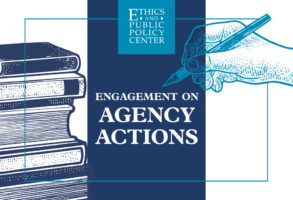
Published October 14, 2014
For the better part of a half century, the New York Times, and similarly situated purveyors of news and opinion, have eagerly awaited the Great Catholic Cave-In: that blessed moment when, at long last, the Catholic Church, like many other Christian communities, would concede that the sexual revolution had gotten it right all along and would adjust its teaching and practice to suit. A Times “breaking story” on October 13, under the headline “Vatican Signals More Tolerance Toward Gays and Remarriage,” might have struck the unwary or uninformed (or those equally committed to the Times agenda in these matters) as a signal that Der Tag, the Day, had finally arrived.
Thus Elisabetta Povoledo wrote that “an important meeting at the Vatican used remarkably conciliatory language on Monday toward gay and divorced Catholics, signaling a possible easing of the church’s rigid attitudes on homosexuality and the sanctity of marriage.” It would be hard to cram more misinformation into one sentence.
1) The notion that the Catholic Church approaches suffering people who struggle with chastity, failing marriages, or both with “rigid attitudes” is slander. Yes, there are priests and bishops who sometimes display a lack of pastoral charity in these difficult circumstances. But they are a distinct minority. As any serious Catholic with experience of the Church’s confessional practice knows, confessors are far more compassionate and understanding than this kind of Dan Brown caricature suggests.
2) Moreover, what the Catholic Church believes about the ethics of human love and about marriage is not a matter of “attitudes.” It’s a matter of truths. Many of those truths can be demonstrated by reason, if people are willing to work through a reasonable argument. Some of those truths, especially those pertaining to the permanence of marriage, come from the Church’s Lord himself. To suggest that any of these truths are matters of “attitude” is another form of slander.
3) And then there’s the slam implicit in that phrase, “rigid attitudes . . . on the sanctity of marriage.” Does the Times now espouse flaccid attitudes toward the sanctity of marriage? Would a culture further corrupted by marital breakdown and divorce be more to the Times’s liking?
4) Beyond these typical bits of Times-speak, Ms. Povoledo utterly misrepresented the document on which she was putatively reporting. It was not issued by “a meeting” or by “the Vatican.” It was not an authoritative document in any sense; it was an interim report on themes that had been raised in the previous ten days of debate and discussion at the synod. It had absolutely no legislative weight — synod documents are consultative, not legislative — and I am told by those who were there that various formulations in the report were seriously criticized in the synod debates. Moreover, the interim report will be chewed over in the ten synod language-based discussion groups — where, one suspects, further criticisms will be aired — before any final report is issued. To turn this kind of interim report into the virtual equivalent of a papal encyclical is ludicrous on its face.
The 2014 synod is an agenda-setting exercise that was intended by Pope Francis to help prepare the work of the 2015 Synod on the Family. The pope knows full well that marriage and the family are in crisis throughout the world. In his own remarks before the synod, he said that he hoped the synod would lift up the beauty of Christian marriage and Christian family life in a world too dominated by what he’s often called a “throwaway culture,” the throwaways all too frequently including spouses and children. That some bishops, theologians, and bishop-theologians from dying local churches in Europe have tried to use the synod to instruct the entire Catholic Church on appropriate pastoral solutions to difficult and tangled human situations will strike some as cheeky, and others as just bizarre. But whatever those synod fathers and advisers thought they were doing, what they effectively have done is to contribute to the false sense that this, at last, is the moment of the Great Catholic Cave-In.
The synod fathers are wrestling with difficult questions. How does the Catholic Church best approach, in a pastoral and charitable way, those who are living in what the Church has no option but to consider, objectively speaking, irregular situations? How does a Church of sinners — which is what all of us Catholics are — call people in those situations to the conversion to which all Christians are constantly called? How can it bring people to see the truth of their situation, and how can it best help them deal with that? These are not simple matters; matters of the heart rarely are. A decent respect for the difficulties and the delicate human situations with which the synod fathers and the pope are grappling demands something better from the putative newspaper of record than a throwaway line about “rigid attitudes.”
And if the Times and others really want to dig into a serious debate that’s underway beneath the surface at the 2014 synod, they might consider this: The experience of the 20th and early 21st centuries suggests that there is an iron law built into the Christian encounter with modernity, according to which Christian communities that maintain a clear sense of their doctrinal and moral boundaries survive and even flourish, while Christian communities whose doctrinal and moral boundaries become porous wither and eventually die. Why have the Catholic leaders who have gotten the most press at this synod, including Cardinal Walter Kasper of Germany, failed to grasp that? Why do they want to emulate the pattern charted by the dying communities of liberal Protestantism? And how do those who have learned that lesson craft pastorally effective strategies that address real situations of suffering without compromising the truth?
That’s the real issue at this synod, and it will be the real issue at its successor next year.
— George Weigel is distinguished senior fellow of Washington’s Ethics and Public Policy Center, where he holds the William E. Simon Chair in Catholic Studies.









